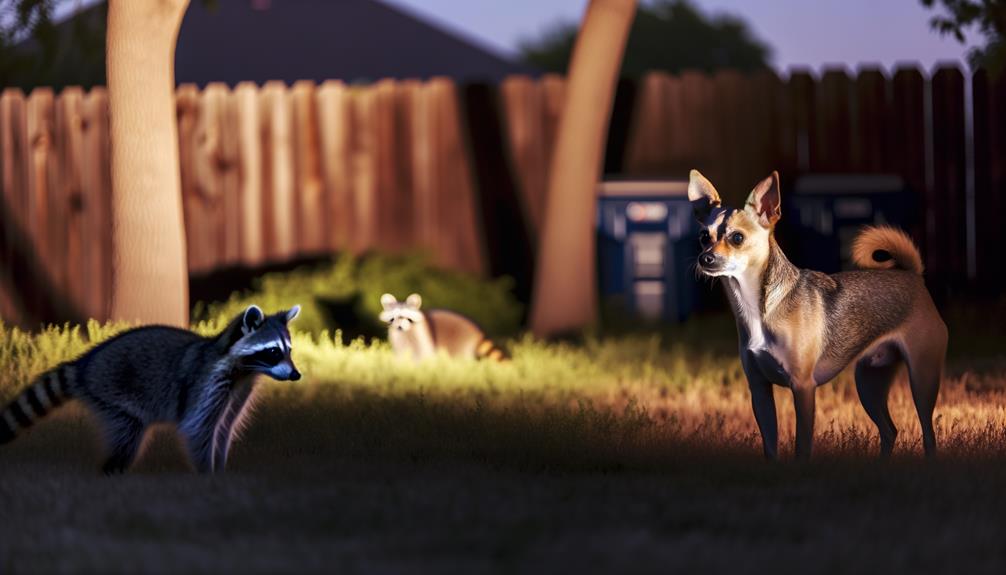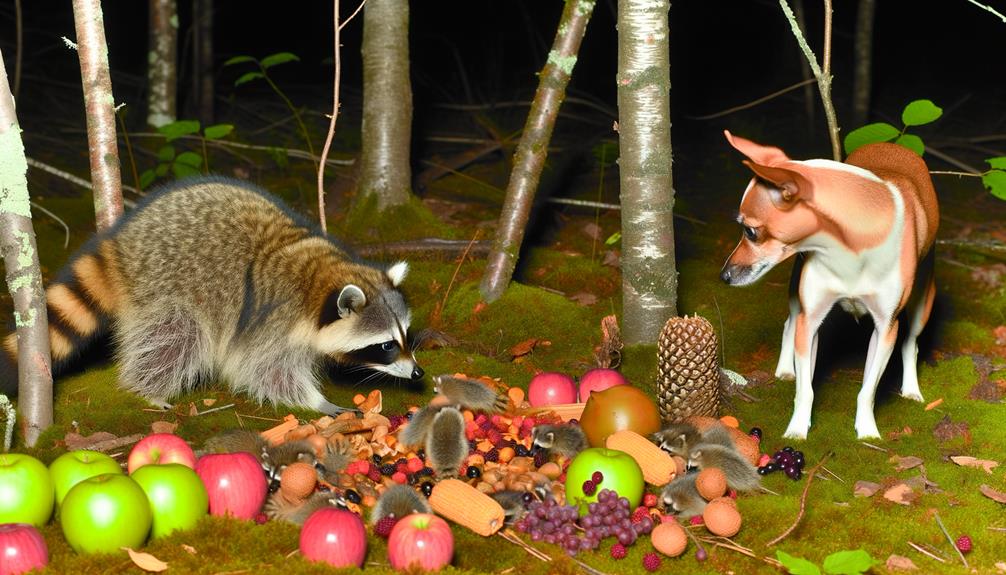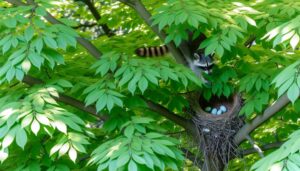Do Raccoons Eat Small Dogs?
While raccoons have an omnivorous diet primarily focused on fruits, nuts, insects, and small vertebrates, it is uncommon for them to prey on small dogs. Typically, aggressive encounters occur if raccoons feel threatened or if small dogs provoke them.
Defensive attacks can result in serious injuries to pets, particularly due to raccoons' problem-solving skills and manual dexterity. These incidents, although rare, often happen in suburban or rural areas where raccoon territory overlaps with human habitats.
Implementing safety measures like securing food sources and supervising pets can mitigate these risks. Examining raccoon behavior further reveals key insights.

Key Takeaways
- Raccoons generally do not eat small dogs but may attack if they feel threatened or cornered.
- Defensive aggression towards small dogs can result in serious injuries, not predation.
- Raccoons perceive small dogs as intruders and may act defensively to protect their territory or young.
- Most raccoon attacks on small dogs occur during dusk or nighttime when raccoons are active.
- Ensuring small dogs are supervised and securing food sources can reduce the risk of raccoon encounters.
Understanding Raccoon Diet

Raccoons (Procyon lotor) exhibit an omnivorous diet, incorporating a wide range of food sources depending on seasonal availability and habitat. Their diet typically includes fruits, nuts, insects, small vertebrates, and aquatic organisms such as crayfish and amphibians.
Raccoons also display opportunistic feeding behaviors, scavenging from human refuse and utilizing available food resources. Studies indicate that their dietary flexibility allows for adaptation to various ecological niches, from urban environments to dense forests. Nutritional intake is further influenced by the raccoon's geographic location and local biodiversity.
This dietary adaptability plays an essential role in their survival and reproductive success, allowing raccoons to thrive in diverse environmental conditions. Understanding these dietary habits is pivotal for accurate ecological management and wildlife conservation efforts.
Raccoon Behavior Patterns
With their highly adaptable nature, raccoons display complex behavior patterns that vary according to environmental stimuli and resource availability.
These nocturnal mammals exhibit a high degree of problem-solving skills and manual dexterity, often manipulating objects to access food sources.
Socially, raccoons are generally solitary but show gregarious behavior during mating seasons and when rearing young.
Their foraging activities are influenced by seasonal variations, with heightened activity in spring and fall.
Territoriality is minimal, though individuals may defend prime foraging areas.
Raccoons show a marked preference for urban environments, where anthropogenic resources are abundant.
Understanding these behaviors is important for evaluating potential interactions between raccoons and domestic animals, including small dogs, within shared habitats.
Documented Incidents

Documented incidents of raccoon attacks on small dogs provide critical insights into the frequency and nature of such encounters.
An overview of reported attacks indicates sporadic occurrences, with a notable distribution in suburban and rural regions.
Common circumstances typically involve raccoons seeking food or defending territory, often during dusk or nighttime hours.
Reported Attacks Overview
Numerous documented incidents highlight the concerning frequency of raccoons attacking small dogs, underscoring a significant yet often overlooked aspect of urban wildlife interactions. Clinical analyses of these events reveal a pattern of aggression that may be attributed to several factors.
Notable cases include:
- Predatory Behavior: Raccoons may exhibit predatory tendencies, especially when food sources are scarce.
- Defensive Actions: Encounters often occur when raccoons feel threatened or are protecting their young.
- Urban Encroachment: Increased human development has led to overlapping habitats, heightening the chances of such confrontations.
These documented cases serve as essential data points for understanding the behavior of raccoons in urban settings and developing effective mitigation strategies to protect small pets.
Geographic Incident Distribution
Examining the geographic distribution of raccoon attacks on small dogs reveals distinct patterns that can inform targeted preventive measures in urban areas. Documented incidents occur mainly in North American regions, particularly within suburban and metropolitan environments where raccoon populations flourish due to abundant food sources and shelter.
| Region | Documented Incidents |
|---|---|
| North-East USA | High |
| South-East USA | Moderate |
| West Coast USA | Moderate |
A higher incidence is noted in the North-East USA, correlating with higher urban density and green spaces. The South-East and West Coast regions exhibit moderate occurrence rates, likely influenced by similar urbanization factors. Such data underscore the need for region-specific preventive strategies to mitigate the risk of raccoon attacks on small domestic canines.
Common Circumstances Involved
Various environmental and situational factors contribute to the common circumstances under which raccoon attacks on small dogs occur. Documented incidents generally highlight the following conditions:
- Proximity to Food Sources: Raccoons are attracted to garbage cans, pet food, and bird feeders. Small dogs can become targets if they are near these resources.
- Nighttime Activity: As raccoons are nocturnal, most attacks on small dogs occur during nighttime walks or when dogs are left outside after dark.
- Territorial Behavior: Raccoons may perceive small dogs as a threat to their territory, particularly during the breeding season or when they have young offspring.
Understanding these factors is essential for mitigating risks and ensuring the safety of small pets.
Expert Opinions
Leading wildlife biologists emphasize that raccoons typically exhibit opportunistic feeding behaviors rather than active predation on small dogs.
Veterinarians underscore the importance of understanding the risk factors and signs of potential raccoon attacks to mitigate harm to pets.
Experts also provide evidence-based prevention and safety strategies to protect small dogs from possible encounters with raccoons.
Wildlife Behavior Insights
Behavioral analysis of raccoons by wildlife experts reveals that while raccoons are opportunistic feeders, incidents of them targeting small dogs are exceedingly rare. Studies indicate that raccoons mainly consume a diet rich in fruits, nuts, and small invertebrates.
When examining raccoon behavior in urban settings, experts have identified several key patterns:
- Dietary Preferences: Raccoons favor easily accessible human food waste over live prey.
- Territorial Nature: They exhibit strong territorial instincts, often avoiding confrontations with animals their own size or larger.
- Nocturnal Activity: Raccoons are mainly nocturnal, reducing interactions with domestic pets.
Veterinarian Risk Assessment
Given the behavioral tendencies of raccoons, veterinarians assess the risk to small dogs as minimal but advise caution in specific circumstances. Raccoons are typically omnivorous scavengers with a preference for easily accessible food sources, hence direct predation on small dogs is infrequent.
However, veterinarians highlight certain risk factors such as the presence of unattended small dogs in areas with high raccoon activity, especially during nocturnal hours when raccoons are most active. Additionally, factors like the presence of food attractants and the raccoon's potential for rabies transmission necessitate vigilance.
While direct attacks are rare, veterinarians emphasize the importance of monitoring small dogs and minimizing opportunities for raccoon encounters to guarantee their safety and well-being.
Prevention and Safety Tips
To effectively mitigate the risk of raccoon encounters, experts recommend implementing a combination of environmental modifications and attentive pet supervision. These strategies are integral in safeguarding small dogs against potential raccoon-related threats.
Key preventative measures include:
- Secure Garbage and Food Sources: Be certain that trash bins are tightly sealed and pet food is not left outdoors, as these attract raccoons.
- Maintain Yard Hygiene: Regularly clean up fallen fruit, birdseed, and other debris that could lure raccoons into your yard.
- Supervised Outdoor Time: Always accompany small dogs when they are outside, especially during dawn, dusk, and nighttime when raccoons are most active.
Adhering to these expert recommendations can notably reduce the likelihood of harmful raccoon interactions.
Raccoons Vs. Small Dogs

The interaction between raccoons and small dogs can be characterized by a complex dynamic of territoriality and predatory behavior. Raccoons, being highly territorial and opportunistic omnivores, may perceive small dogs as intruders or potential threats. This perception often leads to aggressive encounters, particularly if the raccoon feels cornered or its cubs are endangered.
Conversely, small dogs, driven by their instinctual curiosity and territorial nature, may provoke raccoons inadvertently, escalating conflicts. While raccoons do not typically hunt dogs, their defensive aggression can result in serious injuries. Additionally, raccoons are carriers of diseases such as rabies and leptospirosis, posing significant health risks to small dogs.
Understanding these behavioral interactions is essential for managing and mitigating potential conflicts.
Safety Precautions
Mitigating potential conflicts between raccoons and small dogs necessitates the implementation of specific safety precautions to protect both pets and wildlife. Proper measures should be taken to minimize risk and guarantee a harmonious coexistence.
Secure Trash and Food Sources: Raccoons are attracted to easily accessible food. Guarantee all garbage bins are securely closed and avoid leaving pet food outdoors.
Install Fencing: A sturdy fence with no gaps can prevent raccoons from entering the yard. Consider adding a coyote roller to deter climbing.
Supervise Outdoor Activities: Always supervise small dogs when they are outside, particularly during dusk and dawn when raccoons are most active.
Signs of Raccoon Presence

Identifying signs of raccoon presence is vital for early intervention and minimizing potential interactions with small dogs. Typical indicators include overturned garbage cans, scattered refuse, and raccoon tracks characterized by five distinct toes. Additionally, raccoons often leave fecal matter, which may contain undigested food particles and seeds.
Nocturnal vocalizations such as chittering, growling, or squealing can also signal their presence. Structural damage to property, including torn attic insulation or roof shingles, often suggests attempts at nesting. Observing these signs promptly allows for timely measures to mitigate any potential threats to small dogs. Recognizing these indicators accurately ensures informed decision-making and proactive management, thereby safeguarding pet welfare and household integrity.
Deterring Raccoons
Effective raccoon deterrence requires a multifaceted approach that combines habitat modification, exclusion techniques, and the use of repellents.
To effectively reduce raccoon presence in residential areas, consider the following strategies:
- Habitat Modification: Eliminate food sources by securing garbage bins, removing pet food, and keeping compost piles contained.
- Exclusion Techniques: Install raccoon-proof fencing around gardens and secure entry points to attics, basements, and sheds.
- Repellents: Utilize chemical repellents or ultrasonic devices to create an inhospitable environment for raccoons.
These methods, when employed collectively, meaningfully reduce the likelihood of raccoon encounters and mitigate potential risks.
Understanding and implementing these strategies will help maintain a raccoon-free environment, thereby enhancing human and animal safety.
Protecting Your Pets

Ensuring the safety of pets from potential raccoon attacks necessitates a combination of vigilant supervision, secure enclosures, and preventive health measures. Constant monitoring, especially during dawn and dusk when raccoons are most active, reduces the likelihood of encounters.
Constructing robust, raccoon-proof enclosures, utilizing materials such as heavy-duty wire mesh, can effectively safeguard pets. Additionally, maintaining up-to-date vaccinations, including rabies and distemper, is vital for preventing disease transmission.
Implementing motion-activated lights or sprinklers can further deter raccoons from entering residential areas. Lastly, securing garbage bins and eliminating outdoor food sources minimizes attraction. Through these multifaceted strategies, pet owners can significantly mitigate the risks posed by raccoons, ensuring the well-being and safety of their beloved animals.
Conclusion
While raccoons primarily subsist on a diet of fruits, insects, and small vertebrates, documented incidents of raccoons attacking small dogs, though infrequent, do occur.
Expert opinions underscore the significance of implementing safety precautions to mitigate potential conflicts. Observing signs of raccoon presence and employing deterrent methods are imperative.
Consequently, safeguarding domestic pets necessitates a proactive approach to raccoon management, ensuring a harmonious coexistence reminiscent of an era before urban encroachment disrupted natural habitats.






